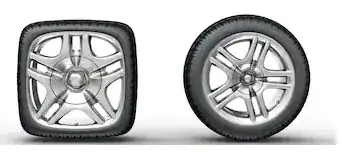This is easiest to understand if you start by considering the extreme cases of steep uphill and downhill slopes.
Actually it isn't true in all cases that running is less efficient than cycling. In work by Minetti et al. ("Energy cost of walking and running at extreme
uphill and downhill slopes," DOI 10.1152/japplphysiol.01177.2001.), it was found that when elite mountain runners run uphill on a treadmill, at slopes greater than about 0.20, the efficiency becomes about 0.25, which is the efficiency of concentric muscle contractions. ("Concentric" means that the direction of motion is in the same direction as the contraction of the muscle, as when you do a pull-up.) This is an upper limit on the efficiency of any human-powered mode of going uphill, so since trained runners achieve it, they are not less efficient than cyclists on these slopes.
On a steep downhill, a cyclist can coast while the leg muscles expend zero energy. Running downhill does consume energy. In fact, the runner's efficiency is negative, because the gravitational potential energy of the person's body decreases, while the body's energy reserves are depleted. Minetti measured the downhill efficiency on grades steeper than $-0.20$ to be $-1.20$, and this is approximately the efficiency of muscles in eccentric contraction (like letting yourself down from a pull-up).
So if we can understand why lowering yourself down from a pull-up expends energy, then we automatically also have a physiological explanation of the imperfect efficiency of downhill running on the steepest grades, and then by interpolation we have an explanation of why running is less efficient than cycling on ordinary slopes or on the flats.
The reason that muscle tissue expends energy in eccentric contractions is that there are processes in the body that dissipate heat when a muscle is under tension. For example, the body has to burn fuel to maintain muscle tension, and there is also internal friction in the muscle as the muscle moves.
In addition to the processes described above, there are other energy-dissipating mechanisms as well, including the dissipation of energy into vibration and sound on a runner's foot strike.
